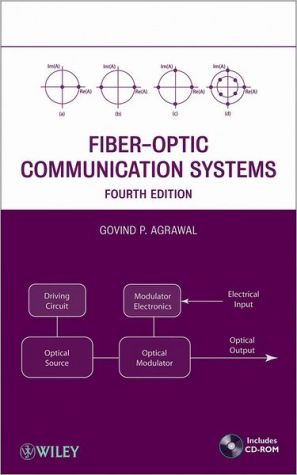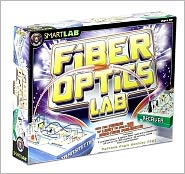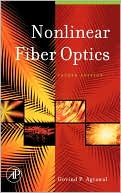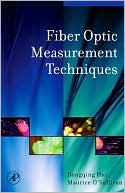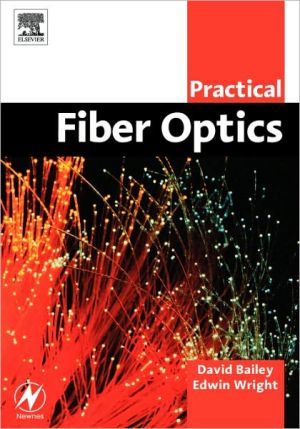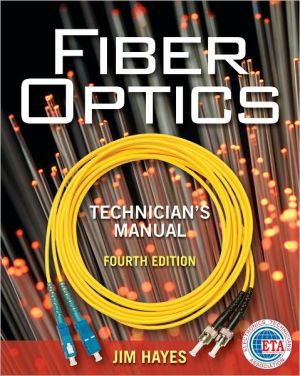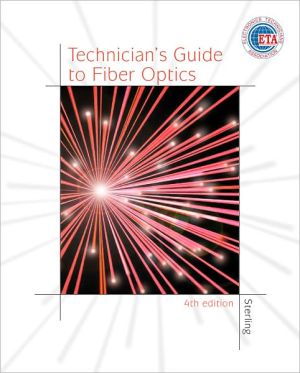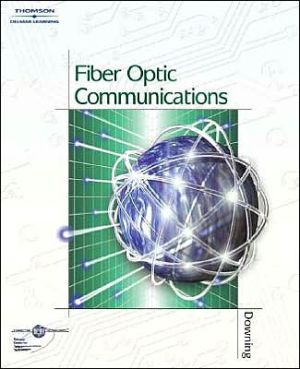Fiber-Optic Communication Systems
This book provides a comprehensive account of fiber-optic communication systems. The 3rd edition of this book is used worldwide as a textbook in many universities. This 4th edition incorporates recent advances that have occurred, in particular two new chapters. One deals with the advanced modulation formats (such as DPSK, QPSK, and QAM) that are increasingly being used for improving spectral efficiency of WDM lightwave systems. The second chapter focuses on new techniques such as all-optical...
Search in google:
Praise for the Second Edition"The book covers an extremely large range of topics and provides an excellent starting point . . . Readers searching for a wide-ranging and up-to-date view of fiber-optic communication systems would do well to purchase this book."-International Journal of Electrical Engineering EducationThe latest edition of a proven bestseller offers comprehensive, up-to-date coverage of fiber-optic communication systems with an emphasis on physical understanding and engineering aspects. The author covers both the systems and components aspects of fiber-optic communication systems with a focus on the physics and technology behind them. The Third Edition has been updated to reflect the current state of the art of lightwave transmission systems, with particular emphasis on the rapid development of the WDM technology and system design issues pertaining to current topics of research. These include new data on lightwave systems design, optical amplification and dispersion-management techniques, multichannel lightwave systems, soliton communication systems, and coherent lightwave systems. Some of the material has been rearranged to facilitate the design of courses in optical communications.Students and researchers alike will benefit from extensive pedagogical aids including:* Extensive reference lists for each chapter* Survey of recent research material for each topic* Relevant end-of-chapter practice problems for teachers and students* Solutions Manual available to teachers on request* System design software on the enclosed CD-ROMAlthough intended primarily as a textbook for graduate students of fiber-optic communications, this book is also a valuable resource for undergraduate courses at the senior level and a valuable professional reference for researchers and engineers working in the fields of telecommunications and lightwave technology. Glass Technology ...an excellent introduction...this is undoubtedly one of the best, most comprehensive and technologically advanced textbooks available...""...I feel this a must for a researcher in the field of fiber-optic communications.
\ \ Chapter 1: Introduction\ A communication system transmits information from one place to another, whether separated by a few kilometers or by transoceanic distances. Information is often carried by an electromagnetic carrier wave whose frequency can vary from a few megahertz to several hundred terahertz. Optical communication systems use high carrier frequencies (- 100 THz) in the visible or near-infrared region of the electromagnetic spectrum. They are sometimes called lightwave systems to distinguish them from microwave systems, whose carrier frequency is typically smaller by five orders of magnitude (- 1 GHz). Fiber-optic communication systems are lightwave systems that employ optical fibers for information transmission. Such systems have been deployed worldwide since 1980 and have indeed revolutionized the technology behind telecommunications. Indeed, the lightwave technology, together with microelectronics, is believed to be a major factor in the advent of the "information age." The objective of this book is to describe fiber-optic communication systems in a comprehensive manner. The emphasis is on the fundamental aspects, but the engineering issues are also discussed. The purpose of this introductory chapter is to present the basic concepts and to provide the background material. Section 1.1 gives a historical perspective on the development of optical communication systems. In Section 1.2 we cover concepts such as analog and digital signals, channel multiplexing, and modulation formats. Relative merits of guided and unguided optical communication systems are discussed in Section 1.3. In Section 1.4 we describe the components of a fiber-optic communication system. The concept of channel capacity is introduced in Section 1.5.\ 1.1 Historical Perspective\ The use of light for communication purposes dates back to antiquity if we interpret optical communications in a broad sense. Most civilizations have used fire and smoke signals to convey a single piece of information (such as victory in a war). Essentially the same idea was used up to the end of the eighteenth century through signaling lamps, flags, and other semaphore devices. The idea was extended further, following a suggestion of Claude Chappe in 1792, to transmit mechanically coded messages over long distances (- 100 km) by the use of intermediate relay stations (acting as regenerators or repeaters). The role of light was simply to make the coded signals visible so that they could be intercepted by relay stations. Such optical communication systems were inherently slow. Indeed, in modern-day terminology, the effective bit rate was less than 1 bit per second (B 1 b/s).\ 1.1.1 Need for Fiber-Optic Communications\ The advent of telegraphy in the 1830s replaced the use of light by electricity and began the era of electrical communications. The bit rate B could be increased to - 10 b/s by the use of new coding techniques, such as Morse code. The use of intermediate relay stations allowed communication over long distances (- 1000 km). Indeed, the first successful transatlantic telegraph cable went into operation in 1866. Interestingly enough, telegraphy used essentially a digital scheme through two electrical pulses of different durations (dots and dashes of the Morse code). The invention of the telephone in 1876 brought a major change inasmuch as electric signals were transmitted in analog form through a continuously varying electric current. Analog electrical techniques were to dominate communication systems for a century or so.\ The development of worldwide telephone networks during the twentieth century led to many advances in the design of electrical communication systems. The use of coaxial cables in place of wire pairs increased system capacity considerably. The first coaxial-cable system, put into service in 1940, was a 3-MHz system capable of transmitting 300 voice channels or a single television channel. The bandwidth of such systems is limited by the frequency-dependent cable losses, which increase rapidly for frequencies beyond 10 MHz. This limitation led to the development of microwave communication systems in which an electromagnetic carrier wave with frequencies of - 1 to 10 GHz is used to transmit the signal by using suitable modulation techniques. The first microwave system operating at the carrier frequency of 4 GHz was put into service in 1948. Since then, both coaxial and microwave systems have evolved considerably and are able to operate at bit rates of - 100 Mb/s. The most advanced coaxial system, put into service in 1975, operates at a bit rate of 274 Mb/s. A severe drawback of such a high-speed coaxial system is the small repeater spacing (- 1 km), which makes the system relatively expensive to operate. Microwave communication systems generally allow for a larger repeater spacing, but their bit rate is also limited by the carrier frequency of such waves. A commonly used figure of merit for communication systems is the bit rate-distance product, BL, where B is the bit rate and L is the repeater spacing. Figure 1.1 shows how the BL product has increased through technological advances during the last century and a half. Communication systems with BL - 100 (Mb/s)-km were available by 1970 and were limited to such values because of fundamental limitations.\ It was realized during the second half of the twentieth century that an increase of several orders of magnitude in the BL product would be possible if optical waves were used as the carrier. However, neither a coherent optical source nor a suitable transmission medium was available during the 1950s. The invention of the laser and its demonstration in 1960 solved the first problem. Attention was then focused on finding ways for using laser light for optical communications. Many ideas were advanced during the 1960s, the most noteworthy being the idea of light confinement using a sequence of gas lenses. It was suggested in 1966 that optical fibers might be the best choice, as they are capable of guiding the light in a manner similar to the guiding of electrons in copper wires. The main problem was the high loss of optical fibers-fibers available during the 1960s had losses in excess of 1000 dB/km. A breakthrough occurred in 1970 when the fiber loss could be reduced to about 20 dB/km in the wavelength region near 1 µm. At about the same time, GaAs semiconductor lasers, operating continuously at room temperature, were demonstrated. The simultaneous availability of a compact optical source and a low-loss optical fiber led to a worldwide effort for developing fiber-optic communication systems. Figure 1.2 shows the progress in the performance of lightwave systems realized after 1974 through several generations of development. The progress has indeed been rapid, as is evident by a many-order-of-magnitude increase in the bit rate-distance product over a period of less than 25 years.\ 1.1.2 Five Generations of Lightwave Systems\ The commercial deployment of lightwave systems followed the research and development closely. After many field trials, the first-generation lightwave systems operating near 0.8 µm became available commercially in 1980. They operated at a bit rate of 45 Mb/s and allowed a repeater spacing of about 10 km. The larger repeater spacing compared with that of a coaxial system was an important motivation for system designers, as it decreased the installation and maintenance costs associated with each repeater.\ It was clear during the 1970s that the repeater spacing could be increased considerably by operating the lightwave system in the wavelength region near 1.3 µm where fiber loss is below 1 dB/km. Furthermore, optical fibers exhibit minimum dispersion in this wavelength region. This realization led to a worldwide effort for the development of InGaAsP semiconductor lasers and detectors operating near 1.3 µm The second generation of fiber-optic communication systems became available in the early 1980s, but the bit rate of early systems was limited to below 100 Mb/s because of dispersion in multimode fibers. This limitation was overcome by the use of single-mode fibers. A laboratory experiment in 1981 demonstrated 2-Gb/s transmission over 44 km of single-mode fiber. The introduction of commercial systems soon followed. By 1987, second-generation 1.3-µm lightwave systems, operating at bit rates of up to 1.7 Gb/s with a repeater spacing of about 50 km, were commercially available.\ The repeater spacing of the second-generation lightwave systems was limited by the fiber loss at the operating wavelength of 1.3 µm (typically, 0.5 dB/km). The loss of silica fibers is minimum near 1.55 µm Indeed, a loss of 0.2 dB/km in this spectral region was realized in 1979. However, the introduction of third-generation lightwave systems operating at 1.55 µm was considerably delayed by large fiber dispersion near 1.55 µm Conventional InGaAsP semiconductor lasers could not be used because of pulse spreading occurring as a result of simultaneous oscillation of several longitudinal modes. The dispersion problem can be overcome either by using dispersion-shifted fibers designed to have minimum dispersion near 1.55 µm or by limiting the laser spectrum to a single longitudinal mode. Both approaches were followed during the 1980s. By 1985, laboratory experiments, indicated the possibility of transmitting information at bit rates of up to 4 Gb/s over distances in excess of 100 km. Third-generation 1.55-µm systems operating at 2.5 Gb/s became available commercially in 1990. Such systems are capable of operating at a bit rate of up to 10 Gb/s. The best performance is achieved using dispersion-shifted fibers together with single-longitudinal-mode lasers.\ A drawback of third-generation 1.55-µm systems is that the signal is regenerated periodically by using electronic repeaters spaced apart typically by 60-70 km. The repeater spacing can be increased by making use of a homodyne or heterodyne detection scheme since its use improves receiver sensitivity. Such systems are referred to as coherent lightwave systems. Coherent systems were under development worldwide during the 1980s, and their potential benefits were demonstrated in many system experiments. However, commercial introduction of such systems had been delayed by the advent of fiber amplifiers in 1989.\ The fourth generation of lightwave systems makes use of optical amplification for increasing the repeater spacing and of wavelength- division multiplexing (WDM) for increasing the bit rate. In such systems, fiber loss is compensated periodically by using erbium-doped fiber amplifiers spaced 60-100 km apart. Such amplifiers were developed during the 1980s and became available commercially by 1990. In 1991, an experiment showed the possibility of data transmission over 21,000 km at 2.5 Gb/s, and over 14,300 km at 5 Gb/s, by using a recirculating-loop configuration. This performance indicated that an amplifier-based, all-optical, submarine transmission system was feasible for intercontinental communication. By 1996, not only transmission over 11,300 km at a bit rate of 5 Gb/s had been demonstrated by using actual submarine cables, but a commercial transpacific cable (TPC-5) also became operational. Figure 1.3 shows the international network of undersea lightwave systems operational in 1996. Many other transoceanic lightwave systems have been planned. The 27,300-km fiber-optic link around the globe (known as FLAG) will begin operation in 1997, linking many Asian and European countries at 5 Gb/s, with several sections operating at 10 Gb/s. Another fiber-optic network, known as Africa One, will circle the African continent and cover a total transmission distance of about 35,000 km. Clearly, the fourth-generation systems have revolutionized the state of the art of lightwave systems.\ The current emphasis of fourth-generation lightwave systems is on increasing the system capacity by transmitting multiple channels through the WDM technique. Optical amplifiers are ideal for multichannel lightwave systems since all channels can be amplified simultaneously without requiring demultiplexing of individual channels. In a 1996 demonstration, twenty 5-Gb/s channels were transmitted over 9100 km in a recirculating-loop configuration, resulting in a total bit rate of 100 Gb/s and the BL product of 910 (Tb/s)-km. In another record experiment, a total bit rate of 1.1 Tb/s was achieved by multiplexing 55 channels, each operating at 20 Gb/s. Despite the use of dispersion-compensation schemes, dispersive effects limited the total transmission distance to 150 km. Commercial WDM systems operating at a bit rate of up to 40 Gb/s were available by the end of 1996. A transpacific system (TPC-6) operating at 100 Gb/s is scheduled to begin operation by the year 2000. The bit rate-distance product for such a system exceeds 900 (Tb/s)-km, indicating the progress realized over a 20-year period.\ The fifth generation of fiber-optic communication systems is concerned with finding a solution to the fiber-dispersion problem. Optical amplifiers solve the loss problem but, at the same time, make the dispersion problem worse since the dispersive effects accumulate over multiple amplification stages. Several dispersion-compensation techniques have been developed, as discussed in Chapter 9. An ultimate solution is based on the novel concept of optical solitons, optical pulses that preserve their shape during propagation in a lossless fiber by counteracting the effect of dispersion through the fiber nonlinearity. Although the basic idea was proposed as early as 1973, it was only in 1988 that a laboratory experiment demonstrated the feasibility of data transmission over 4000 km by compensating the fiber loss through stimulated Raman scattering. Erbium-doped fiber amplifiers were used for soliton amplification starting in 1989. Since then, many system experiments have demonstrated the eventual potential of soliton communication systems. By 1994, solitons were transmitted over 35,000 km at 10 Gb/s and over 24,000 km at 15 Gb/s. In a 1996 recirculating-loop experiment, soliton transmission over 9400 km was demonstrated at a bit rate of 70 Gb/s by multiplexing seven 10-Gb/s channels.\ Even though the fiber-optic communication technology is barely two decades old, it has progressed rapidly and has reached a certain stage of maturity. This is also apparent from the publication of a large number of books on optical communications since 1991. This text, first published in 1992, is intended to present an up-to-date account of fiber-optic communications systems with an emphasis on recent developments....
Preface1Introduction11.1Historical Perspective11.2Basic Concepts81.3Optical Communication Systems151.4Lightwave System Components162Optical Fibers232.1Geometrical-Optics Description232.2Wave Propagation282.3Dispersion in Single-Mode Fibers372.4Dispersion-Induced Limitations452.5Fiber Losses552.6Nonlinear Optical Effects592.7Fiber Manufacturing673Optical Transmitters773.1Basic Concepts773.2Light-Emitting Diodes873.3Semiconductor Lasers923.4Control of Longitudinal Modes993.5Laser Characteristics1063.6Transmitter Design1184Optical Receivers1334.1Basic Concepts1334.2Common Photodetectors1364.3Receiver Design1494.4Receiver Noise1554.5Receiver Sensitivity1624.6Sensitivity Degradation1684.7Receiver Performance1745Lightwave Systems1835.1System Architectures1835.2Design Guidelines1885.3Long-Haul Systems1955.4Sources of Power Penalty2025.5Computer-Aided Design2176Optical Amplifiers2266.1Basic Concepts2266.2Semiconductor Optical Amplifiers2326.3Raman Amplifiers2436.4Erbium-Doped Fiber Amplifiers2506.5System Applications2617Dispersion Management2797.1Need for Dispersion Management2797.2Precompensation Schemes2817.3Postcompensation Techniques2867.4Dispersion-Compensating Fibers2887.5Optical Filters2907.6Fiber Bragg Gratings2937.7Optical Phase Conjugation3007.8Long-Haul Lightwave Systems3057.9High-Capacity Systems3108Multichannel Systems3308.1WDM Lightwave Systems3308.2WDM Components3398.3System Performance Issues3628.4Time-Division Multiplexing3758.5Subcarrier Multiplexing3818.6Code-Division Multiplexing3889Soliton Systems4049.1Fiber Solitons4049.2Soliton-Based Communications4119.3Loss-Managed Solitons4189.4Dispersion-Managed Solitons4279.5Impact of Amplifier Noise4359.6High-Speed Soliton Systems4459.7WDM Soliton Systems45810Coherent Lightwave Systems47810.1Basic Concepts47910.2Modulation Formats48210.3Demodulation Schemes48710.4Bit-Error Rate49010.5Sensitivity Degradation49710.6System Performance507App. A: System of Units518App. B: Acronyms520App. CGeneral Formula for Pulse Broadening524App. DUltimate System Capacity527App. E: Software Package529Index531
\ Optik: International Journal for Light and Electron OpticsThe first edition of this book is well known all over the world and had a great echo anywhere.... Because of...rapid advances it was necessary to bring out the second edition in order to continue to provide a comprehensive and up-to-date account of fiber-optic communication systems.\ \ \ \ \ OptikThe first edition of this book is well known all over the world and had a great echo anywhere.... Because of...rapid advances it was necessary to bring out the second edition in order to continue to provide a comprehensive and up-to-date account of fiber-optic communication systems.\ \ \ Glass Technology...an excellent introduction...this is undoubtedly one of the best, most comprehensive and technologically advanced textbooks available...""...I feel this a must for a researcher in the field of fiber-optic communications.\ \ \ \ \ From The CriticsPhysical understanding and engineering aspects of fiber optic communication systems are emphasized in this book/CD-ROM text covering both the systems and components of fiber optic communication systems and the physics and technology behind them. This third edition has been updated to reflect the current state of the art in lightwave transmission systems, with particular emphasis on the rapid development of WDM technology and on system design issues pertaining to current topics of research. The companion CD-ROM contains system design software. Although intended as a text for graduate students of fiber optics communications, the book can also be a resource for senior undergraduate courses and a reference for researchers and engineers in telecommunications and lightwave technology. Agrawal teaches at the Institute of Optics at the University of Rochester. Annotation c. Book News, Inc., Portland, OR (booknews.com)\ \ \ \ \ BooknewsA textbook for a graduate or senior undergraduate engineering course on optical communications, containing enough material that a selection of topics is required to fit into one semester. Emphasizes the physical understanding of fiber-optic technology, but also discusses engineering aspects. Updated and considerably expanded from the 1992 edition. Annotation c. by Book News, Inc., Portland, Or.\ \ \ \ \ BooknewsGraduate textbook and reference. While engineering aspects are discussed, the focus is on a physical understanding of the subject. Topics include: optical fibers, optical sources and transmitters, optical detectors and receivers, coherent lightwave systems, multichannel communication systems, optical amplifiers, and soliton communication systems. Includes problems at the end of each chapter. Annotation c. Book News, Inc., Portland, OR (booknews.com)\ \ \ \ \ From the Publisher"Despite the otherwise excellent quality of the book, there are also several typos, in the text as well as in the problems." (Optics and Photonics News, 13 May 2011)\ \
